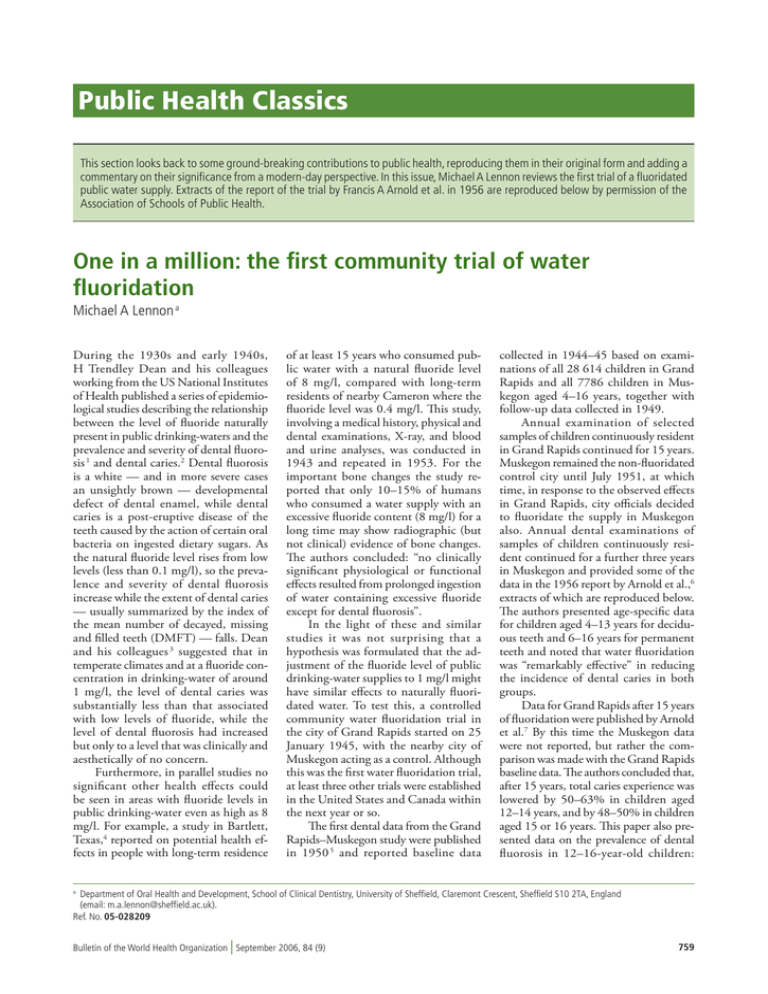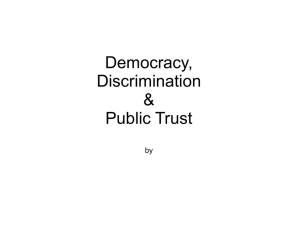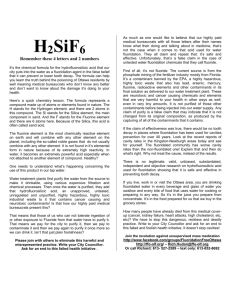Public Health Classics
advertisement

Public Health Classics This section looks back to some ground-breaking contributions to public health, reproducing them in their original form and adding a commentary on their significance from a modern-day perspective. In this issue, Michael A Lennon reviews the first trial of a fluoridated public water supply. Extracts of the report of the trial by Francis A Arnold et al. in 1956 are reproduced below by permission of the Association of Schools of Public Health. One in a million: the first community trial of water fluoridation Michael A Lennon a During the 1930s and early 1940s, H Trendley Dean and his colleagues working from the US National Institutes of Health published a series of epidemioll logical studies describing the relationship between the level of fluoride naturally present in public drinking-waters and the prevalence and severity of dental fluorosl sis 1 and dental caries.2 Dental fluorosis is a white — and in more severe cases an unsightly brown — developmental defect of dental enamel, while dental caries is a post-eruptive disease of the teeth caused by the action of certain oral bacteria on ingested dietary sugars. As the natural fluoride level rises from low levels (less than 0.1 mg/l), so the prevall lence and severity of dental fluorosis increase while the extent of dental caries — usually summarized by the index of the mean number of decayed, missing and filled teeth (DMFT) — falls. Dean and his colleagues 3 suggested that in temperate climates and at a fluoride concl centration in drinking-water of around 1 mg/l, the level of dental caries was substantially less than that associated with low levels of fluoride, while the level of dental fluorosis had increased but only to a level that was clinically and aesthetically of no concern. Furthermore, in parallel studies no significant other health effects could be seen in areas with fluoride levels in public drinking-water even as high as 8 mg/l. For example, a study in Bartlett, Texas,4 reported on potential health effl fects in people with long-term residence of at least 15 years who consumed publl lic water with a natural fluoride level of 8 mg/l, compared with long-term residents of nearby Cameron where the fluoride level was 0.4 mg/l. This study, involving a medical history, physical and dental examinations, X-ray, and blood and urine analyses, was conducted in 1943 and repeated in 1953. For the important bone changes the study repl ported that only 10–15% of humans who consumed a water supply with an excessive fluoride content (8 mg/l) for a long time may show radiographic (but not clinical) evidence of bone changes. The authors concluded: “no clinically significant physiological or functional effects resulted from prolonged ingestion of water containing excessive fluoride except for dental fluorosis”. In the light of these and similar studies it was not surprising that a hypothesis was formulated that the adjl justment of the fluoride level of public drinking-water supplies to 1 mg/l might have similar effects to naturally fluoridl dated water. To test this, a controlled community water fluoridation trial in the city of Grand Rapids started on 25 January 1945, with the nearby city of Muskegon acting as a control. Although this was the first water fluoridation trial, at least three other trials were established in the United States and Canada within the next year or so. The first dental data from the Grand Rapids–Muskegon study were published in 1950 5 and reported baseline data collected in 1944–45 based on examinl nations of all 28 614 children in Grand Rapids and all 7786 children in Muskl kegon aged 4–16 years, together with follow-up data collected in 1949. Annual examination of selected samples of children continuously resident in Grand Rapids continued for 15 years. Muskegon remained the non-fluoridated control city until July 1951, at which time, in response to the observed effects in Grand Rapids, city officials decided to fluoridate the supply in Muskegon also. Annual dental examinations of samples of children continuously residl dent continued for a further three years in Muskegon and provided some of the data in the 1956 report by Arnold et al.,6 extracts of which are reproduced below. The authors presented age-specific data for children aged 4–13 years for deciduol ous teeth and 6–16 years for permanent teeth and noted that water fluoridation was “remarkably effective” in reducing the incidence of dental caries in both groups. Data for Grand Rapids after 15 years of fluoridation were published by Arnold et al.7 By this time the Muskegon data were not reported, but rather the compl parison was made with the Grand Rapids baseline data. The authors concluded that, after 15 years, total caries experience was lowered by 50–63% in children aged 12–14 years, and by 48–50% in children aged 15 or 16 years. This paper also presl sented data on the prevalence of dental fluorosis in 12–16-year-old children: Department of Oral Health and Development, School of Clinical Dentistry, University of Sheffield, Claremont Crescent, Sheffield S10 2TA, England (email: m.a.lennon@sheffield.ac.uk). Ref. No. 05-028209 a Bulletin of the World Health Organization | September 2006, 84 (9) 759 Public Health Classics Michael A Lennon Water fluoridation and dental caries 10.6% of the children showed some evidence of dental fluorosis but most (10.2%) of these cases were of the nearly imperceptible, questionable or very mild degrees of severity. In 1950, the Chief Dental Officer of the United States Public Health Service, Bruce D Forsyth, issued a policy stateml ment to the American Dental Associatl tion that “the fluoridation of public water supplies … can be encouraged subject to the approval of the State and local health authorities and the dental and medical profession”. Surgeon General Leonard A Scheele reaffirmed fluoridation as an official policy of the Public Health Service in testimony before the Senate in April 1951.8 In 1958, a WHO Expert Committee concluded that “drinkingwater containing about 1 ppm fluoride (1 mg/l) has a marked caries-preventive action … There is no evidence that water containing this concentration of fluoride impairs general health.” 9 By 1960, water fluoridation was being widely implemented and around 50 million people in the United States were benefiting; by 2002, 46 of the 50 largest cities were fluoridated, with a total population covered of 171 million (68% of those on public water systems). Indeed, the United States appears to be on target towards meeting its Healthy people 2010 objective on community water fluoridation: 75% of people on public water systems to receive water that has the optimal level of fluoride recomml mended for preventing tooth decay,10 and, worldwide, around 350 million people to consume fluoridated water.11 Of course, the quality of the Grand Rapids–Muskegon study was to some extent compromised by, among other issues, the decision to fluoridate the control community after five years. Subsl sequent studies have achieved higher quality standards.12–14 Nevertheless, becl cause it was the first such study, because it was directly linked to and logically folll lowed on from the earlier epidemiologicl cal studies, and because of its worldwide impact, the pioneering study by Arnold et al. rightly holds its place among the public health classics. O References 1. Dean H, Elvove E. Further studies on the minimal threshold of chronic endemic dental fluorosis. Public Health Rep 1937;52:1249-64. 2. Dean H, Arnold FJ, Elvove E. Domestic water and dental caries. V. Additional studies of the relation of fluoride domestic waters to dental caries experience in 4,425 white children, aged 12 to 14 years, of 13 cities in 4 States. Public Health Rep 1942;57:1155-79. 3. Dean HT, Jay P, Arnold FA, Elvove E. Domestic water and dental caries ll. A study of 2,832 white children aged 12-14 years, of 8 suburban Chicago communities, including lactobacillus acidophilus studies of 1,761 children. Public Health Rep 1941;56:761-92. 4. Leone NC, Shimkin MB, Arnold FA, Stevenson CA, Zimmerman ER, Geiser PA. Medical aspects of excessive fluoride in water supply. Public Health Rep 1954;69:925-36. 5. Dean HT, Arnold FA, Jay P, Knutson JW. Studies on mass control of dental caries through fluoridation of the public water supply. Public Health Rep 1950;65:1403-8. 6. Arnold FA Jr, Dean HT, Jay P, Knutson JW. Effect of fluoridated public water supplies on dental caries prevalence. 10th year of the Grand RapidsMuskegon Study. Public Health Rep 1956;71:652-8. 7. Arnold FA, Likens RC, Russell AL, Scott DB. Fifteenth year of the Grand Rapids fluoridation study. J Am Dent Assoc 1962;65:780-5. 8. McClure FJ. Water fluoridation – the search and the victory. Bethesda (MD): US Department of Health Education and Welfare, NIH, NIDR; 1970. Chapter 14:247-9. 9. World Health Organization. Fluorides and oral health First report of the Expert Committee on Water Fluoridation. Geneva: WHO; 1958. WHO Technical Report Series, No 146. 10. US Department of Health and Human Services. Healthy people 2010: understanding and improving health, 2nd ed. Washington (DC): US Government Printing Office; 2000. 11. British Fluoridation Society. One in a million – the facts about water fluoridation. Manchester: British Fluoridation Society; 2004. Available from: http://www.bfsweb.org/onemillion.html 12. Dirks OB, Houwink B, Kwant GW. The results of 6 1/2 years of artificial fluoridation of drinking water in the Netherlands. The Tiel-Culemborg experiment. Arch Oral Biol 1961;5:284-300. Medline doi:10.1016/00039969(61)90065-6 13. Hardwick JL, Teasdale J, Bloodworth G. Caries increments over 4 years in children aged 12 at the start of water fluoridation. Br Dent J 1982;153: 217-22. Medline doi:10.1038/sj.bdj.4804904 14. McDonagh M, Whiting P, Bradley M, Cooper J, Sutton A, Chestnut I, et al. A systematic review of public water fluoridation. York: The University of York NHS Centre for Reviews and Dissemination; 2000. Report 18:214. Corrigendum In Vol. 84, issue number 8, 2006, page 674, in the 20th line of the first full paragraph in column 2 and in the last bullet point in column 3, the “ > ” [greater than] symbol should be “ > ” [greater than or equal to]. 760 Bulletin of the World Health Organization | September 2006, 84 (9)




